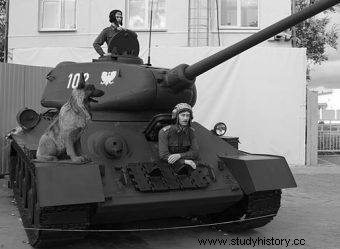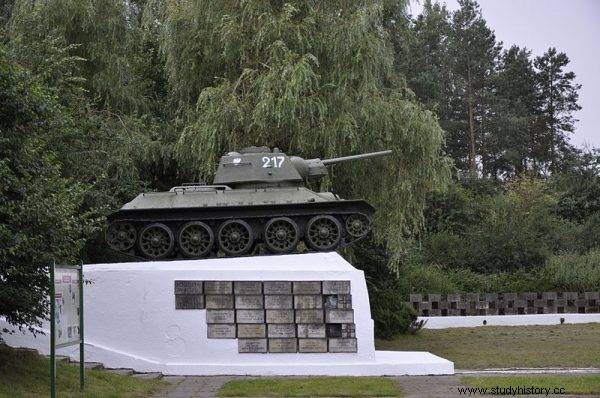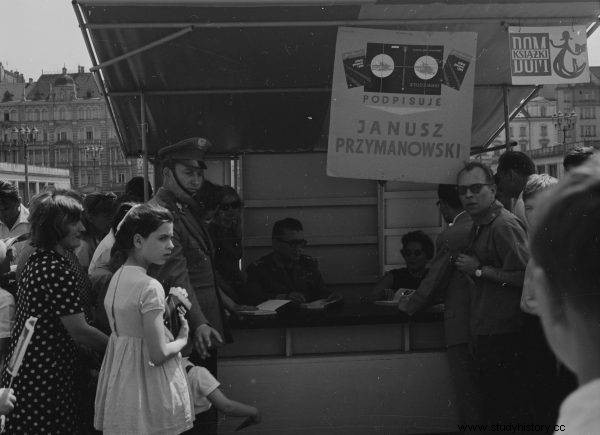In August 1944, a bloody tank battle took place near Studzianki on the Vistula River. It lasted 8 days. The Red Army soldiers fighting the "Gierings" were supported by Polish tankers. The crew of the tank No. 102 under the command of Lieutenant Wacław Feryniec stood out in particular. It is true that there was no name "Rudy" on the side of the tank, but the crew did have the dog Sharik. The dog was stolen.
At the end of July 1944, the Red Army reached the Vistula. In several places, she even managed to cross the river. The 8th Guards Army was ordered to maintain the Warka-Magnuszew bridgehead at all costs, and then start another offensive deep into Poland. The Germans knew what was going on and wanted to liquidate the bridgehead at all costs.
Side number 102
General Nikolaus von Vormann sent to the Warka region the elite 1st Armored and Parachute Division Hermann Göring and not worse than it:the 19th Armored Division and the 45th Grenadier Division. Seasoned veterans of battles on all fronts served in all of them. The Hermann Goring division recently distinguished itself in the fighting for the Anzio bridgehead in Italy, where it stopped the American offensive. In the summer of 1944, she was brought to the Vistula River. Now she was supposed to push the Ivans to the river, but not only them…

The Red Army soldiers fighting the "Gierings" were supported by Polish tankers. The crew of the tank No. 102 under the command of Lieutenant Wacław Feryniec stood out in particular.
On August 9, a German counterattack in the southern part of the Warka-Magnuszew bridgehead interrupted the defense of the 4th Guard Corps. In the area of the village of Studzianki the Germans stuck into the Soviet positions for about 2 kilometers and were slowly moving towards the Vistula . Taking advantage of the accuracy and long range of the guns, German tanks easily destroyed Soviet tanks.
To save the situation, General Vasily Chuikov, commander of the 8th Guards Army, had to support the defense with an armored unit as soon as possible. The closest was the Polish 1st Armored Brigade. Heroes of Westerplatte. On August 9, in the afternoon, Polish tankmen went to help the guards. No bridges have been built on the Vistula yet, and there was only one ferry on the key section. The tanks were moved to the other side one by one. After unloading, they immediately went into action.

Monument to the fallen in the Battle of Studzianki
On August 10, lieutenant Feryniec's machine arrived across the Vistula. The commander of the car was ordered to reach the severed Soviet battalions that were running out of ammunition. He led the rally across the front line on his tank No. 102. He was supported by two light T-70 cars, commanded by Second Lieutenant Julian Messing and Ensign Stefan Sirota. In another section, a similar order to reach the encircled ones was given to the crew of tank No.100 of standard-bearer Rudolf Szczepanik.
Lieutenant Feryniec quickly realized that anything can happen in a war ...
Battle with "Gierings"
In the book "I survived the war ... The last soldiers of fighting Poland," Piotr Korczyński writes:
As the wagons traversed another forest gap, they suddenly hit a line of trenches. Feryniec, standing in the hatch open all the time, noticed that the machine guns placed on them were Russian - these were Maxims and Diegtiarov's rifles. He jumped out of the wagon and called to greet him in Russian. Yes, he got the answer in that language, but with it - a pepesha series.
It turned out that the outer line of the encirclement was secured by Vlasovs - soldiers of Russian origin fighting alongside the Germans under the command of a collaborator, General Andrei Vlasov . Feryniec had both his legs shot through, but the wounded man was pulled into the tank. Despite his injuries, he decided to lead and continue the breakthrough.
Polish tankers managed to reach the cut-off unit and provided it with food, ammunition and dressings. After completing the mission, they returned to their own, and the wounded Feryniec was sent to the rear - to the field hospital. Fortunately, his injuries did not turn out to be serious and he returned to the unit in the fall of 1944.
The battle with the "Gierings", as the Russians called them, continued for a few more days. Studzianki were repeatedly captured, lost and recaptured, but finally on August 15 the breach in the front line was closed. By August 16, the last German units fighting in the cauldron were crushed or forced to retreat. The 1st Armored Brigade destroyed 20 tanks and self-propelled guns as well as 9 armored personnel carriers in battle. It lost 26 tanks, of which only 9 were repaired.
Czterej pancerni - true story
It is not my intention in this short article to compare the historical truth with the plot told in the series Czterej pancerni i pies because other authors have done it before. However, there is no doubt that Janusz Przymanowski, the author of the book and then the script of the cult series based on it, faithfully reproduced the course of the Battle of Studzianki.
It should be remembered that his book was a novel, and the series was historical-adventure, not documentary. It is true that some details do not match, such as the name of the commander of the encircled battalion - in fact it was Captain Ivan Bielanin. But let's not demand too much.

Janusz Przymanowski, author of the book, and then the script of the cult series based on it, faithfully reproduced the course of the Battle of Studzianki.
From PAW Claw we remember the scene when the "Siberian", who did not recognize the approaching tank, throws a grenade under the caterpillars of "Rudy". Similar situations with the so-called friendly fire really took place near Studzianki. For example, a Soviet artilleryman, surprised by the appearance of the tank where it was not supposed to be, aimed and fired, hitting the turret. The tank hit was Soviet. Fortunately, the missile ricocheted, the tank didn't suffer too much and the crew survived.
In another scene, Olgierd and Janek Kos crawl to a damaged German tiger, from which they then shoot at the Germans. The story seems unbelievable, but it did happen during the Battle of Studzianki! The author of this feat was Captain Viktor Tiufiakow, a Russian assigned to the 1st Armored Brigade, commander of tank No. 110. For the operation at Studzianki, he was awarded the Order of Virtuti Militari V class.
The sharik was… stolen
It is not known if the dog Sharik participated in the battle, as depicted in the series. Presumably the tankers left him behind. From the memories of Feryniec recorded by Korczyński it appears that the dog was not brought to Poland from the outskirts of the Soviet Union. He joined the crew in the spring of 1944 in Kiwierce, Ukraine. Interestingly, the Sharik was… stolen. Korczyński writes in his book:
While camping in the Kiwi forest, Feryniec and his soldiers often visited the local forester. There they noticed that his female dog had three puppies. One of them was extremely small and looked like a ball. Gruszczyński liked the dog (radio operator of tank no. 102), who simply stole it during one of his next visits. The Woodsman made a fuss at first, but eventually his wife pacified him and he waved his hand. And so Kulka, or Szarik, became a crew member of the barn and rode under its armor.

From the memories of Feryniec recorded by Korczyński it appears that the dog was not brought to Poland from the outskirts of the Soviet Union. He joined the crew in the spring of 1944 in Kiwierce, Ukraine. Interestingly, the Sharik was… stolen.
The author emphasizes that the tank No. 102 was not named "Rudy" in honor of the Soviet nurse, because the brigade did not have the custom of giving the machines proper names. Przymanowski was certainly a careful observer and an insightful chronicler, but he did not lack his writing fantasy. It should not be forgotten that he was also a political officer, or "commissar" of the 5th Heavy Artillery Brigade.
The author of the book "I survived the war ... The last soldiers of fighting Poland", ends the chapter on Feryniec and its tank No. 102, with a surprising conclusion:
Colonel Wacław Feryniec was reluctantly returning to his wartime experiences. He considered this chapter to be happily but irretrievably closed. His son, also Wacław, found out that his father was the commander of the legendary 102 tank after he had already had a childhood fascination with the series Four tankers and a dog . He even had regret, because if he knew that he was the progenitor of Olgierd Jarosz and Janek Kos, the kid in the yard would be king.
The colonel constantly insisted that he had achieved nothing special and that the heroes were those who died. (...) Colonel Feryniec did not like the next, overly colored episodes of the series about the adventures of Rudy's crew. For him, the war ended happily, but he couldn't quite shake off the horror he experienced in it. He preferred to be silent. He died on April 18, 2017.
